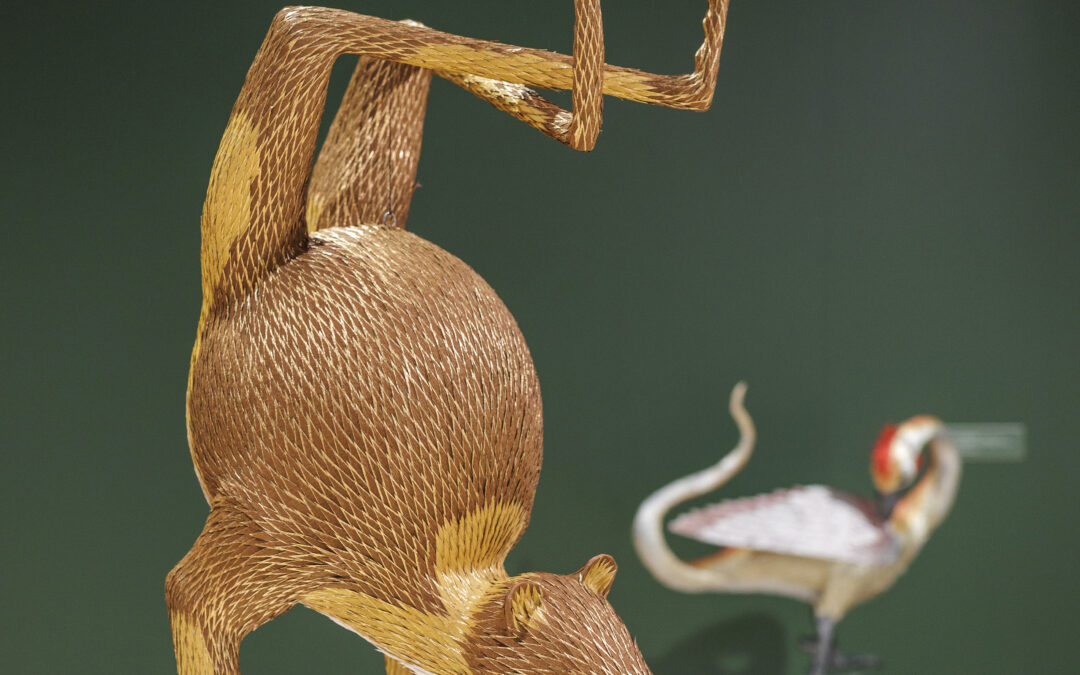Roberto Benavidez, Bosch Beast No. 4, 2017. Paper, paperboard, glue, crepe paper, and wire, 36 x 22 x 12”. (Photo by Echard Wheeler)
By Betsy DiJulio
In the minds and hands of 13 artists, lowly paper is elevated. Generally thought of as a support for other media or the stuff of which traditional folk arts are made, the paper in this show will give you pause.
Hailing from across the US and Canada, the artists included in the exhibition have proven that paper need not play a supporting role. Innovative macro and micro approaches to layering, suspending, cutting, collaging, weaving, folding, patterning, and scattering might leave the impression that these artists are formalists enamored with the medium. And while that may be true to an extent, make no mistake, these artists also take on weighty content from identity to spirituality, history to the cosmos, and the creation and destruction of knowledge.
Taken together, work speaks volumes. And to help us read between the lines, Holly Koons, executive director of the Torggler, was gracious enough to answer a few questions.
BD: Is “The Possibilities of Paper” a traveling exhibition or was it curated in-house? If the former, will you share a little context? If the latter, what criteria influenced your selection of these thirteen artists?
HK: The exhibition was curated in-house. It’s part of a series of exhibitions examining contemporary art and materiality that began with last summer’s “Flora/Fauna/Fiber.” Artists were selected based on the quality of their work and the diversity of approaches to working with paper. In the end, the selected artists hailed from coast to coast in addition to Canada.
BD: Who are a couple of examples of artists in the show that may defy visitor expectations in regard to an exhibition about paper?
HK: Samuelle Green’s remarkable “Marshmallow Polypore II” is perhaps the most surprising work. This site-specific “cave” is created entirely from chicken wire and folded pages from books, and visitors are lured into its fascinating interior. Roberto Benavidez’s “Bosch Beasts” are also particularly unique. Benavidez creates artful, refined piñatas inspired by art history—in this case, Hieronymus Bosch’s “Garden of Earthly Delights.” The blend of cultural and artistic traditions is captivating—as are the “creatures” themselves.
BD: Though somewhat similar, can you share an example or two of artists who expand on conventional perceptions of how paper is used by artists?
HK: With one exception, none of the exhibiting artists use paper as a traditional support for another medium. Paper is the protagonist, whether it retains two-dimensional form or becomes something closer to sculpture. Cutting, typically by hand, is one primary means of altering the paper, but artists also saw, excavate, layer, and weave paper to achieve different aesthetic effects.
BD: What can you tell us about both the most expansive installation and the most intimate piece in the show?
HK: There are actually several expansive site-specific installations in the show, ranging from Jaq Belcher’s floor installation created from meticulously cut and scattered paper, to Charles Clary’s 40-foot wall installation of dozens of diverse works that form a whole, to Michael Velliquette’s suspended, pristine folded forms. Among the more intimate works in the show are a piece by Rosa Leff—cut paper towel that resembles fine lace–and altered books by Guy Laramée and Doug Beube that transform cast off books into vast landscapes or compositions resembling archeological digs.
BD: In your mind, which artist or piece of art reimagines traditional art forms in an especially compelling way?
HK: Artists like Rosa Leff, who was originally inspired by Mexican papel picado, transforms this decorative cutting tradition into a means of rendering complex urban landscapes. Matt Schlian creates complex “paper engineered” forms that far exceed conventional notions of traditional folded paper, or origami. And Benavidez’s piñatas are a delightful re-thinking of a commonplace object associated with Mexican celebratory rituals.
BD: Also on view is “The Magical World of Paper Kimonos” and “Art is Ageless.” Why should visitors make sure to see these exhibitions while at the Torggler?
HK: “Art is Ageless” is a show installed in our William Grace Community Gallery devoted to works by Hampton Roads artists. In this case, the gallery features works by members of CNU’s Lifelong Learning program. In our Academic Gallery, “The Magical World of Paper Kimonos” displays the inventive work of Williamsburg artist Caroline Garrett Hardy who offers a local spin on the creative use of paper. Hardy creates decorative kimonos and costumes that incorporate paper rubbings as well as folded, collaged, and cut paper.
WANT TO SEE?
The Possibilities of Paper
Through October 15
Torggler Fine Arts Center, Christopher Newport University, Newport News
fergusoncenter.org




